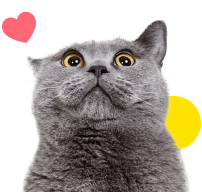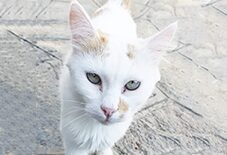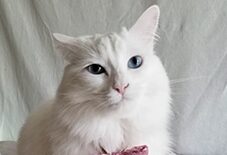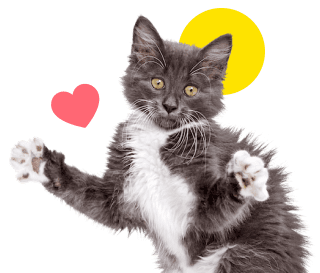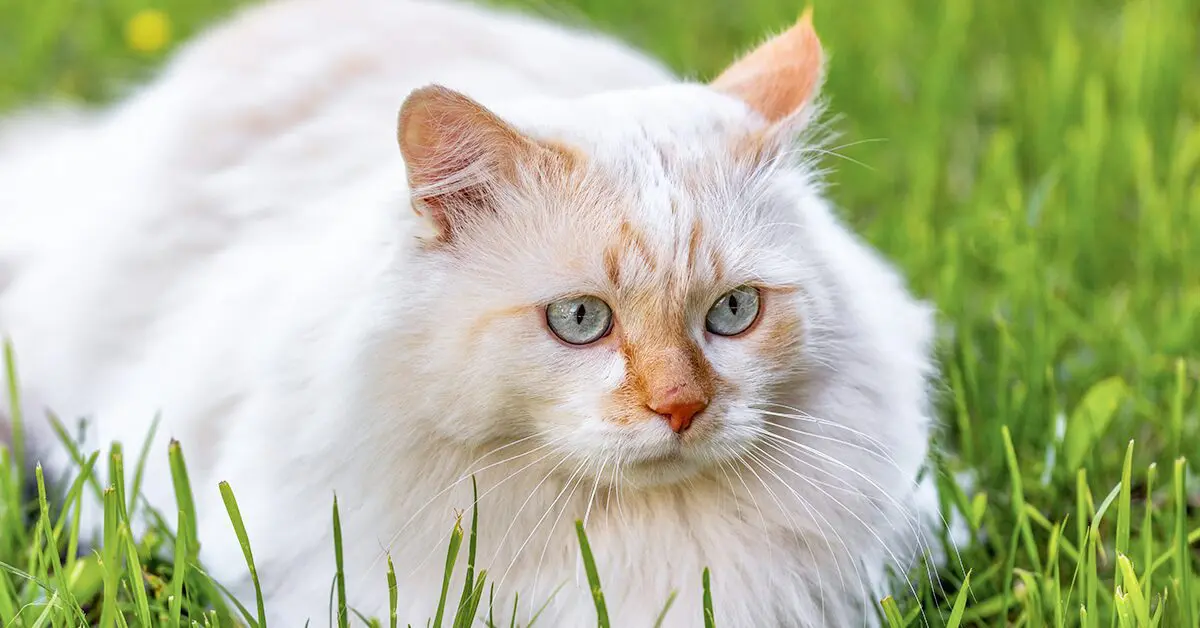
Meet the Turkish Angora
Best Fur Friend
High Kitty I.Q.
Social Butterfly
Want a graceful beauty with a big personality and a bigger heart? Then I’m the breed for you! We Turkish Angoras are known for our elegance, which is why the humans call us the ballerinas of the cat world! I’m very loving – if a bit clingy – so I do best in a home where I’m not left alone for too long. I can get along with kids and cat-friendly pets, but I’ve got an alpha personality, so I’ll let them know who’s boss!
I’m an outgoing and social cat who needs all eyes on me, and I’ll use my smarts and mischievous nature to make sure they are. Don’t be surprised to find me opening cabinets or knocking stuff over to get your attention! But It doesn’t take as much work as you’d think to keep me looking furbulous – twice-weekly brushing is enough. I’m also pretty athletic and need daily exercise to work my energy out, so stock up on interactive toys and make time to play with me! Even though I can be a bit of a handful sometimes, the humans can’t get enough of my stunning looks and charming personality.
Ready to learn more about me? Let’s dig in.
Ready to learn more about me? Let’s dig in.
 My Many Looks
My Many Looks
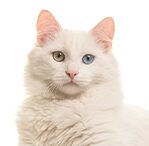
White
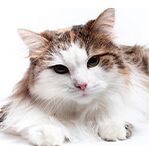
Calico
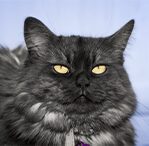
Tortoiseshell
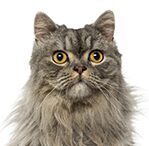
Silver Tabby
 My Breed Characteristics
My Breed Characteristics
 Furbulous Fact
Furbulous Fact
Some Turkish Angoras have a genetic condition called heterochromia, which is linked to white fur. The humans call this look “odd eyes,” and white Turkish Angoras with these genes will have one blue eye and one green, green-gold, or amber eye. This rare look is prized by Turkish Angora lovers, but (as in other breeds) white fur and blue eyes can be linked to deafness. Not all odd-eyed Turks are deaf, but deaf kitties need love, too!
 As I Grow Up
As I Grow Up
As you can see, we Turkish Angoras age pretty gracefully. Here are a few key milestones in my growth & development to be aware of as I grow up from a kitten to an adult and senior!
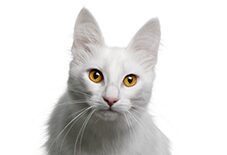
Kitten3-9 Months
I’m prone to gum disease, so get me used to teeth brushing early on – I’ll love the attention, and treats always help!
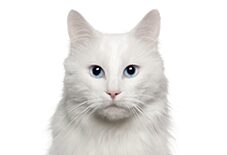
Adult1.5-2 Years
I’m an active breed, but I’m prone to obesity. Make sure I have lots of toys and a tall cat tree so I can work out my energy and stay fit!
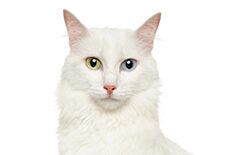
Senior11-12 Years
I’m slowing down, so make sure to switch to a senior formula cat food and take me to the vet for twice-yearly check-ups.
 History of My Breed
History of My Breed
We Turkish Angoras are a very old breed. My earliest ancestors evolved naturally from the African wildcat – they lived in the Ankara region of Turkey (then called Angora). The humans think our long fur first evolved to protect us from the cold in the Turkish mountains. My ancestors came to Europe in the 16th century, and our grace and beauty made us popular among royalty in Great Britain and France. Queen of France Marie Antoinette famously loved our breed, and some humans believe that, when she was attempting to flee France during the French Revolution, she put her six Turks on a ship to America, where they bred with domestic cats to create the Maine Coon!
In late-19th- and early-20th-century Europe, Turkish Angoras were featured prominently in cat shows, but the growing popularity of the Persian breed almost wiped us out. The humans saw how gorgeous our coats were, and they started breeding us with Persians to make their coats as nice as ours, but we almost went extinct as a separate breed in the process. Luckily, humans at the Ankara Zoo in our ancestral home of Turkey considered us a national treasure, and they started a strict breeding program to bring us back.
The Ankara Zoo program focused on white Turkish Angoras with blue, gold, or odd eyes, and the striking looks of these traditional Turks caught the eyes of American servicemen who were stationed in Turkey. In 1962, the breeders at the zoo allowed Colonel Walter Grant to take two Turks back to America, where he started a breeding program. In 1973, the Cat Fanciers’ Association recognized us, but only white Turkish Angoras were allowed. The CFA didn’t recognize colored Turkish Angoras until 1978. While some humans still think my white brothers and sisters are the most beautiful, today all of our colors and patterns are celebrated by Turkish Angora lovers around the world.
 Pawesome Cats to Parent
Pawesome Cats to Parent
In addition to purebred Turkish Angoras like me, there are tons of prrrfectly sweet mixed-breed Turks that are looking to find their furever homes. You can learn where to find your next pet below!
 Care Tips
from Dr. Corinne Wigfall, Veterinarian
Care Tips
from Dr. Corinne Wigfall, Veterinarian 
Brush your Turkish Angora often to avoid hairballs.
Turkish Angora cats have medium-long fur coats, which require brushing once to twice a week with a fine toothed comb. This will help reduce excess hair, prevent matted fur, and reduce the possibility of hairballs. Anti-hairball oral supplements, such as Cat Lax paste, can be offered to help break these down.
Keep an eye on your Turkish Angora’s eyes.
Their long fur can also predispose Turkish Angoras to irritation around their eyes. To avoid discharge accumulation, clean around their eyes with a damp cloth to remove debris. This will reduce risk of bacterial conjunctivitis. Long hair at the corner of the eye can cause direct irritation on the surface of the eye itself, which can cause corneal ulcers, so make sure this area of fur is trimmed.
Keep your white Turkish Angora indoors.
Due to lack of skin pigmentation, white Turkish Angoras are more at risk for sunburn. For this reason, they are more suited to indoor living. White Turkish Angoras with blue or odd eyes are more prone to being deaf. If this is the case they may appear louder when vocalizing. Although cats adapt well to being deaf, it is better to keep them indoors to avoid the risks of being outside (i.e. not hearing for dangers like cars or other animals).
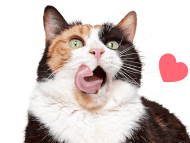
 Why Get Cat Insurance?
from Pumpkin®
Why Get Cat Insurance?
from Pumpkin®
While Turkish Angoras are a generally healthy breed, cat-astrophes can happen to any cat at any age. If your kitty gets hurt or sick, pet insurance can help you say ‘yes’ to the best care, even when it’s costly. When it comes to shopping for this breed, you’ll want to choose insurance plans like Pumpkin's, which can help cover the costs associated with the hereditary conditions Turks are prone to developing. While a reputable breeder will conduct genetic testing on your kitty’s parents to help minimize the chances of passing down hereditary conditions, they can’t always be avoided. Let’s look at some common ones, and how Pumpkin Cat Insurance plans could help cover the cost of care!
 Heart Disease
Heart Disease
Turkish Angoras may develop heart problems, specifically Hypertrophic Cardiomyopathy (HCM). In this condition, the muscle walls of the heart thicken causing a decline in cardiac function. While there is no cure, heart disease can be managed with medication and dietary changes.
- Cost to Treat
- $500-$3,000
- Pumpkin Pays Back*
- $450-$2,700
 Diabetes Mellitus
Diabetes Mellitus
Cats with diabetes do not produce enough insulin to convert the glucose (sugar) in their blood into cellular energy. This can cause excessive urination, weight loss, and can lead to various infections. Diabetes can be managed with diet change, weight loss, and insulin injections.
- Cost to Treat
- $500-$5,000
- Pumpkin Pays Back*
- $450-$4,500
 Periodontal Disease
Periodontal Disease
Periodontal (gum) disease occurs when plaque builds up, forming a layer of tartar that inflames the gums. Left untreated, gums weaken and separate from teeth. While routine brushing, cleanings, and antibiotic gels help treat milder cases, severe ones require surgery.
- Cost to Treat
- $400-$1,200
- Pumpkin Pays Back*
- $360-$1,080
 Ataxia
Ataxia
Ataxia is a sensory dysfunction caused by lesions in the brain, inner ear, or spinal cord that affect a cat’s motion and balance. If the case is hereditary, it’s incurable. If it’s caused by a tumor, cancer, or infection then chemotherapy, radiation, and medication are used to treat.
- Cost to Treat
- $200 to $4,000
- Pumpkin Pays Back*
- $180-$3,600
*Example illustrates reimbursement of a covered vet bill at a 90% reimbursement rate, where the annual deductible had already been satisfied and the annual limit had not yet been met. Coverage and reimbursement results vary based on policy options.
